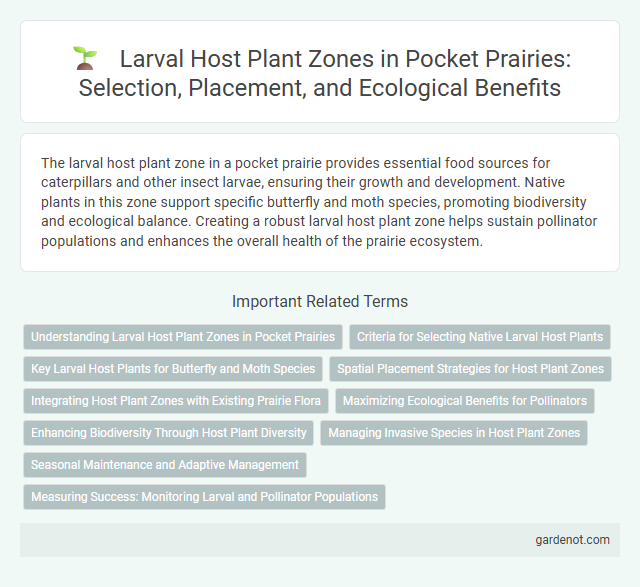The larval host plant zone in a pocket prairie provides essential food sources for caterpillars and other insect larvae, ensuring their growth and development. Native plants in this zone support specific butterfly and moth species, promoting biodiversity and ecological balance. Creating a robust larval host plant zone helps sustain pollinator populations and enhances the overall health of the prairie ecosystem.
Understanding Larval Host Plant Zones in Pocket Prairies
Larval host plant zones in pocket prairies are critical for supporting butterfly and moth populations by providing specific plants needed for caterpillar development. These zones are strategically designed to include native species that attract and sustain larvae during their growth stages, enhancing local biodiversity. Understanding the spatial arrangement and plant species preferences within these zones is essential for effective pocket prairie conservation and habitat restoration.
Criteria for Selecting Native Larval Host Plants
Selecting native larval host plants for a pocket prairie involves prioritizing species that support local butterfly and moth larvae by providing essential nutrients and habitat. Criteria include plant adaptability to regional climate and soil conditions, high larval survivorship rates, and compatibility with surrounding plant species to ensure biodiversity and ecosystem balance. Native plants with documented ecological relationships and minimal maintenance requirements enhance long-term sustainability and effectiveness of the larval host plant zone.
Key Larval Host Plants for Butterfly and Moth Species
Key larval host plants in pocket prairies include native grasses such as little bluestem (Schizachyrium scoparium) and wildflowers like purple coneflower (Echinacea purpurea) that support diverse butterfly and moth species. Milkweed species (Asclepias spp.) are essential for monarch butterfly larvae, providing critical food sources for successful metamorphosis. Incorporating these native host plants enhances habitat quality and promotes local pollinator biodiversity in pocket prairie ecosystems.
Spatial Placement Strategies for Host Plant Zones
Strategic spatial placement of larval host plant zones in pocket prairies maximizes habitat connectivity and supports butterfly and moth populations' lifecycle requirements. Positioning host plants near nectar sources and sheltered areas enhances larval survival rates and adult pollinator activity. Integrating native species with overlapping phenologies ensures continuous resource availability across developmental stages while optimizing microclimate conditions for larvae.
Integrating Host Plant Zones with Existing Prairie Flora
Integrating larval host plant zones with existing prairie flora enhances biodiversity by promoting native butterfly and moth populations essential for ecosystem health. Selecting native grasses and forbs that serve as larval host plants ensures compatibility with regional climates and soil conditions, improving survival rates and habitat resilience. This approach supports pollinator networks and strengthens ecological balance within pocket prairie restorations.
Maximizing Ecological Benefits for Pollinators
Larval host plant zones in pocket prairies create essential habitats that support the life cycles of native pollinators by providing necessary resources for caterpillars and other insect larvae. Selecting diverse, native plant species such as milkweed, goldenrod, and asters enhances biodiversity and promotes pollinator population growth. Strategically planting these zones maximizes ecological benefits by sustaining pollinators through all development stages, boosting local ecosystem resilience.
Enhancing Biodiversity Through Host Plant Diversity
Larval host plant zones increase biodiversity by supporting various butterfly and moth species that rely on specific native plants for reproduction and development. Incorporating a wide range of native host plants in pocket prairies fosters habitat complexity and sustains pollinator populations vital for ecosystem resilience. This diversity in early life-stage plant relationships promotes a robust, self-sustaining environment, enhancing overall ecological balance.
Managing Invasive Species in Host Plant Zones
Managing invasive species in larval host plant zones requires targeted removal of non-native plants that threaten native butterfly habitats, ensuring the survival of essential host plants like milkweed and violets. Employing manual weeding and selective herbicides minimizes ecological disruption while promoting native biodiversity in pocket prairies. Regular monitoring and rapid response to invasive species outbreaks maintain the integrity of larval host plant zones critical for successful butterfly reproduction.
Seasonal Maintenance and Adaptive Management
Seasonal maintenance of pocket prairies in the larval host plant zone involves monitoring plant health and removing invasive species to support native butterfly populations. Adaptive management practices include adjusting mowing schedules and plant selection based on observed larval growth and habitat conditions to enhance biodiversity. Regular assessments help optimize habitat quality, ensuring the sustainability of larval host plants throughout the growing season.
Measuring Success: Monitoring Larval and Pollinator Populations
Monitoring larval and pollinator populations in pocket prairies involves systematic surveys to track species diversity and abundance, providing critical data on ecosystem health. Using standardized protocols like visual counts and sweep netting helps measure the effectiveness of larval host plant zones in supporting target butterfly and moth species. Long-term data collection enables adaptive management strategies to enhance habitat quality and promote pollinator population growth.
Larval host plant zone Infographic

 gardenot.com
gardenot.com